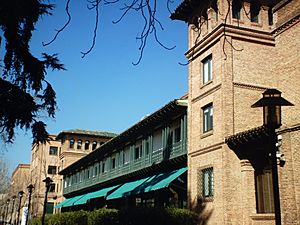Residencia de Estudiantes facts for kids
The Residencia de Estudiantes means "Student Residence" in English. It is a very important place for Spanish culture in Madrid. This special place was started to give students a home, much like old colleges in places like Bologna, Cambridge, or Oxford.
It quickly became a famous cultural spot. It helped smart young thinkers, writers, and artists in Spain grow their ideas. Famous students who lived here included Salvador Dalí, Luis Buñuel, and Federico García Lorca. Many important people also visited and gave talks, like Marie Curie and Albert Einstein.
The Residencia was a lively place for science and art in Europe between the two World Wars. Its activities stopped during the Spanish Civil War. After the war, it became a guesthouse. Now, it is working hard to be a leading cultural center again.
Contents
History of the Residencia
The Residencia de Estudiantes was started in Madrid in 1910. It was created by a group called the Junta para Ampliación de Estudios. This group aimed to improve education in Spain. Until 1936, the Residencia was a busy and successful place for new ideas in science and art.
In 1915, it moved to its current home. The director, Alberto Jiménez Fraud, made the Residencia a place where people could share ideas. It was a place for creativity and talking about different subjects. The ideas for the Residencia came from the Institución Libre de Enseñanza, a school founded in 1876.
The main goal of the Residencia was to add to university learning. It wanted to create an exciting place for students to live and think. It strongly encouraged linking science and art. It also welcomed new ideas from other countries. It became a key place for spreading modern ideas in Spain.
Some of the students who lived there became very famous. These include the poet Federico García Lorca, the painter Salvador Dalí, the filmmaker Luis Buñuel, and the scientist Severo Ochoa, who won a Nobel Prize. Many other writers and artists also visited often. These included Miguel de Unamuno, Manuel de Falla, and José Ortega y Gasset.
Famous Visitors
The Residencia was also a place where important ideas from Europe were shared. Many famous people came to the Residencia to talk and discuss. These visitors included Albert Einstein, Paul Valéry, Marie Curie, and Igor Stravinsky.
These important people were often invited by two private groups. These groups worked closely with the Residencia. They helped connect the Residencia to more people in society.
Spain's "Silver Age" of Ideas
The early 1900s in Spain are called the Silver Age. This was a time when many new ideas came out. Words and images became very powerful in art and politics. This Silver Age is often divided into three main groups of thinkers:
- Generation of '98
- Generation of '14
- Generation of '27
The Residencia de Estudiantes was very important from 1910 until the Spanish Civil War started in 1936. During this time, many Spanish artists and writers visited, studied, and gave talks there. These included Federico García Lorca, Luis Buñuel, Salvador Dalí, and José Ortega y Gasset. Other great thinkers from around the world also visited, like Albert Einstein and Marie Curie.
The Residencia was one of the most important places of its time. It brought together great thinkers to share their ideas. People at the Residencia also started a tradition called tertulias. These were groups of artists and writers who met daily. They would gather in cafes, bars, or homes to talk about their ideas.
The Spanish Civil War brought an end to this special time of ideas. Scientific progress slowed down. Many artists and writers had to leave the country. There was also more censorship in Spain under Franco's rule.
The Residencia Today
Today, the Residencia de Estudiantes is one of the most important cultural centers in Madrid. It hosts concerts, talks, and art shows. In 2015, it received the European Heritage Label. This award recognized its big role in European history and culture.
About 20 talented young artists and researchers live at the Residencia. They help keep the history of this place alive. Some of these creators include Mercedes Cebrián and David Mayor.
The Residencia is still a unique place in Spain's cultural life. It is managed by an independent foundation. It is also connected to the Spanish National Research Council (CSIC). Many important people help run the Residencia. The honorary president is the Prince of Asturias.
Throughout the year, the Residencia holds many public events. Leading figures in arts and sciences take part. These events include talks, workshops, concerts, and art shows. This makes the Residencia a place for open discussion and new ideas.
Each year, over 3,000 scholars, artists, and other professionals visit. They stay at the Residencia for short periods.
The Residencia has a special library and archives. They hold many unique documents and books. These focus on Spain's intellectual and scientific history in the early 1900s. The private papers of Federico García Lorca are kept here.
The Residencia also publishes books. It shares research, old texts from its archives, and talks given there.
Media Interest
The movie Little Ashes (2009) shows the Residencia in the 1920s. It tells the story of the friendship between Lorca, Dalí, and Buñuel when they were living there.
See also
 In Spanish: Residencia de Estudiantes para niños
In Spanish: Residencia de Estudiantes para niños


